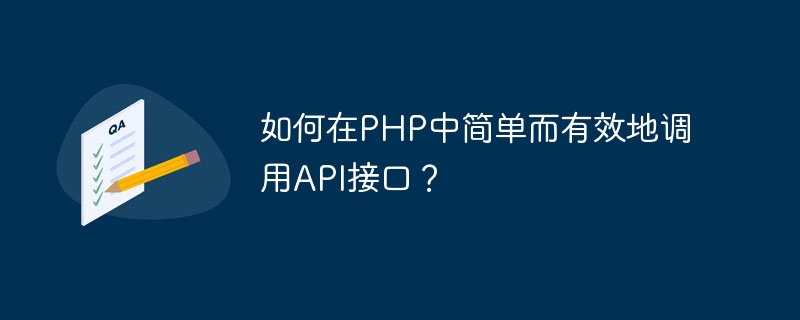Home >Backend Development >PHP Tutorial >How to call API interface simply and effectively in PHP?
How to call API interface simply and effectively in PHP?
- WBOYWBOYWBOYWBOYWBOYWBOYWBOYWBOYWBOYWBOYWBOYWBOYWBOriginal
- 2023-09-05 17:18:251470browse

How to call API interface simply and effectively in PHP?
With the continuous development of the Internet, the use of API (Application Programming Interface, application program interface) is becoming more and more common. Through APIs, different applications can communicate with each other and share data, providing developers with more possibilities. In this article, we will learn how to call API interfaces in PHP simply and effectively.
First of all, we need to understand the basic concepts of API. An API is a contract between software components that defines how to request data and how to receive and process responses. Usually, APIs use different HTTP methods to perform different operations, such as GET for getting data, POST for creating data, PUT for updating data, and DELETE for deleting data.
There are many ways to call API interfaces in PHP, the most commonly used of which is to use the cURL library. cURL is a powerful tool that can send HTTP requests and get response data. The following is a simple example that demonstrates how to use cURL to call the API interface:
<?php
// 创建一个cURL句柄
$ch = curl_init();
// 设置请求的URL
curl_setopt($ch, CURLOPT_URL, "http://api.example.com/users");
// 设置请求方法为GET
curl_setopt($ch, CURLOPT_HTTPGET, true);
// 执行请求并获取响应数据
$response = curl_exec($ch);
// 检查是否有错误发生
if(curl_errno($ch)) {
echo 'Error: ' . curl_error($ch);
}
// 关闭cURL句柄
curl_close($ch);
// 处理响应数据
$data = json_decode($response, true);
echo "Total users: " . count($data);
?>In the above example, we first create a cURL handle using the curl_init() function. Then, use the curl_setopt() function to set the requested URL and request method. Next, use the curl_exec() function to execute the request and save the response data in the $response variable. curl_errno()The function is used to check whether an error occurs, and if so, prints an error message. Finally, use the json_decode() function to parse the response data into an array and perform further processing.
In addition to cURL, PHP also provides some other methods to call API interfaces, such as using the file_get_contents() function, using HTTP extensions, etc. The following is an example of using the file_get_contents() function:
<?php // 设置请求的URL $url = "http://api.example.com/users"; // 发送HTTP请求并获取响应数据 $response = file_get_contents($url); // 处理响应数据 $data = json_decode($response, true); echo "Total users: " . count($data); ?>
In the above example, we use the file_get_contents() function to send a GET request and save the response data in $ response variable. Then, use the json_decode() function to parse the response data and perform further processing.
No matter which method is used, you need to pay attention to the following points when calling the API interface:
- Make sure you have the correct request URL, HTTP method and parameters;
- Check the API documentation to learn how to construct requests and handle responses;
- Handle error messages, such as using the
curl_errno()function to get the cURL error code; - Understand the identity of the API Authentication method, such as including an API key or token in the request.
By learning the methods shown in this article, you can simply and effectively call API interfaces in PHP. Whether getting data, creating data or updating data, it can all be achieved by properly configuring HTTP requests. Understanding the basic concepts of APIs and adjusting code according to API documentation will help you better use and develop APIs. I wish you success in calling the API interface!
The above is the detailed content of How to call API interface simply and effectively in PHP?. For more information, please follow other related articles on the PHP Chinese website!

